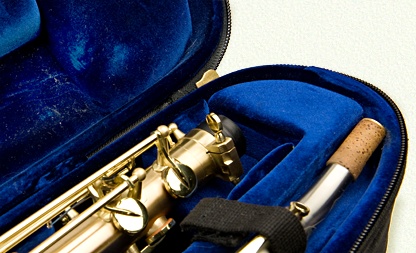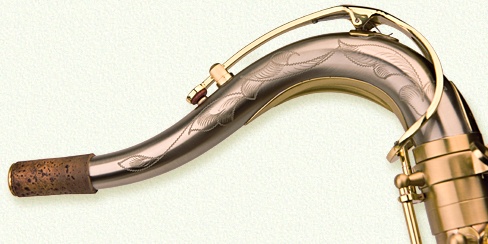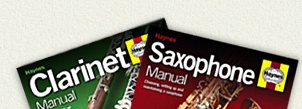P Mauriat Le Bravo 200 tenor saxophone
 Origin:
Taiwan (www.pmauriatmusic.com) Origin:
Taiwan (www.pmauriatmusic.com)
Guide price: £1600
Weight: 3.4kg
Date of manufacture: 2010
Date reviewed: March 2014
Mauriat's stab at the intermediate market - with
a mixed bag of features
The intermediate-quality instrument market is a hard place in which to
do business. Student models are nearly always bought on price, pro models
on performance - but the middle ground is all about getting the balance
right. Too cheap, and no-one will take you seriously; too dear and you
simply won't come up to scratch. It's difficult, too, from the point of
view of knowing what (and what not) to provide. Fortunately (for the buyer)
there's a lot of competition, and with each manufacturer having slightly
different ideas about what constitutes an intermediate horn, there's a
nice range of choice.
And it's into this cut-throat market that Mauriat have pitched their Bravo
200.
It's a decent-looking horn, with its matt finish lacquer on a rose brass
body with contrasting gold lacquered brass keys - and the nicely
engraved "Silver VI" nickel crook makes it look very businesslike.
The large bell diameter is a nice touch at this price point- it's
156mm (6 1/8"), which is just a tad smaller than the large-belled
TJ RAW tenor.
The construction is fairly typical; drawn toneholes, which were all nice
and level and neatly finished off; semi-ribbed pillars - which means a
combination of standalone pillars and small groups of pillars fitted to
plates on the main stack action and all the usual mod-cons, such as a
detachable bell, an adjustable metal thumb hook and a triple-point bell
stay. There's also a large, slightly convex brass thumb rest, a large
sling ring, adjusters on the bell key bumper felts and a semicircular
compound bell key pillar...though this doesn't have any additional bracing,
such as you'd find on the Bauhaus
M2.
I'd say the body build quality was pretty good - nice and tidy, with no
sloppy solderwork and an even coat of lacquer.
The keywork was similarly nicely finished, and fitted with proper
mother-of-pearl touchpieces (or in this case, Abalone - which is
much the same, just more decorative). The main stack pearls are
slightly concave, with a slightly domed Bis Bb pearl (which makes
for a smoother transition when rolling your finger off the B key).
Likewise, G# and side F# touchpieces feature slightly domed Abalone
pearls.
The design of the keywork is fairly straightforward - plain and functional
seems to be the best description. There are no-nonsense fork and pin connectors
on the side Bb and C keys, a swivel arm octave key mech and a tilting
table for the bell keys.
 You
get adjusters for the G#/Bis Bb and the low C# - but there are no adjusters
on the main stacks, either for key height or regulation. I feel this is
a bit mean at this price point - and the use of fairly thick, standard
cork for the stack regulators isn't going to help matters. You
get adjusters for the G#/Bis Bb and the low C# - but there are no adjusters
on the main stacks, either for key height or regulation. I feel this is
a bit mean at this price point - and the use of fairly thick, standard
cork for the stack regulators isn't going to help matters.
However, there's some use of felt up and down the action, which will go
some way to keeping the action noise down a bit.
And it'll be needed. As with many Mauriats I've seen, the action rattled
a fair bit. A great deal of this will be down to the use of parallel point
screws. These have a tapered tip on them, but because the pivot holes
in the key barrels are drilled deeper than the length of the point screw's
tip they're completely ineffectual.
I also noticed some wobbling on the palm keys. I could put this down to
fair wear and tear, but as this horn's only four years old and with no
signs of heavy use, I think it highly likely that the wobbles were there
from the off. The keys are finished off with decent, well-set pads and
the action is powered by blued steel springs.
The setup was average. Given the age of the horn it's hard to comment
accurately about it, but I noted the spring tension was set way
too heavy. It could be that the horn has had some work done to it
in the last four years, but I'm inclined to doubt that anyone would
elect to have the action set this hard- or that any repairer would
consider it an ideal setup. The key heights were spot on though.
 The
horn came in a shaped semi soft case. Seems decent enough, but a whack
to the case led to some nasty damage to the top F# upper pillar. I've
often moaned about the size of pillar bases on pillars that are especially
vulnerable to knocks, and this proves my point. A larger base would have
spread the impact force; it might not have prevented the damage, but it
would have lessened it...and that can be the difference between your horn
being playable or not after a light knock. It's a little odd, because
all the other standalone pillars have decent-sized bases. The
horn came in a shaped semi soft case. Seems decent enough, but a whack
to the case led to some nasty damage to the top F# upper pillar. I've
often moaned about the size of pillar bases on pillars that are especially
vulnerable to knocks, and this proves my point. A larger base would have
spread the impact force; it might not have prevented the damage, but it
would have lessened it...and that can be the difference between your horn
being playable or not after a light knock. It's a little odd, because
all the other standalone pillars have decent-sized bases.
There's not much storage space inside the case - a compartment for the
mouthpiece and one for the crook, and that's your lot. Anything else will
have to go in one of the three zippered bags attached to the exterior
of the case...though one of them is big enough to take a flute in a case.
I hate the lack of storage space inside the case - even a small compartment
for reed and cork grease would be good enough, simply because these are
precisely the sort of things I want immediately to hand when I open the
case.
It seems I'm not alone, because this case was littered with free-floating
reed cases, pegs and bit of paper...some of which had found their way
into the bore of the horn.
 The
horn felt fine under the fingers (after a decent set up). Modern horns,
for the most part, have the ergonomics nailed...at least for the vast
majority of players. Everything was where I expected it to be, and the
use of grease rather than oil for the ill-fitting point screws had helped
to quieten the action considerably. The
horn felt fine under the fingers (after a decent set up). Modern horns,
for the most part, have the ergonomics nailed...at least for the vast
majority of players. Everything was where I expected it to be, and the
use of grease rather than oil for the ill-fitting point screws had helped
to quieten the action considerably.
Tonewise it's a credible performer. As expected at this price point it
has a 'middle of the road' feel to it - not too bright, not too warm (despite
the tonal claims the manufacturer's blurb makes for the rose brass) and
even-toned across the range. It's stable too, there's no sense that it
will run away with you. This makes it a solid platform, and many a player
who's upgrading from a student-quality instrument will immediately notice
how much more in control the Bravo puts them.
And while that's a quality worth shouting about , it's also something
of a limitation because it comes across as quite a 'dry' horn.
It's the difference between playing your horn in the lounge - with the
furniture, carpets and curtains acting together to deaden the sound -
and playing in the bathroom, where the harder surfaces add a bit of an
echo (or reverb, as its known in the trade). The former is a dry sound,
the latter a 'wet' one. Some horns seem to have an inbuilt reverb; it's
small, granted, but it's still there - and it lends the tone a bit of
depth. It's like looking for the last morsel at the bottom of a soggy
bag of chips, or tipping your pint glass to get that last drop of beer
out...it's that sense of reaching for more, of hoping that it's there.
The Bravo seem to have a definite cut-off point. What you hear is what
you get.
There's still a decent bit of crackle to the low notes, and enough edge
to the top notes to allow them to cut through nicely - in fact I quite
liked the solidity of the palm key notes.
 None
of this makes it a bad horn though, it just makes it different - and some
players will find that the horn's temperament complements their mouthpiece
setup and playing style perfectly. It's also not the case that the stability
means it lacks response - it might not have as much immediacy as I'd like,
but it's got enough. None
of this makes it a bad horn though, it just makes it different - and some
players will find that the horn's temperament complements their mouthpiece
setup and playing style perfectly. It's also not the case that the stability
means it lacks response - it might not have as much immediacy as I'd like,
but it's got enough.
The tuning is, as expected, just fine.
Perhaps the biggest problem for the Bravo is the competition. £1600
is a fair chunk of cash to splash on a horn - and when buyers perhaps
lack the confidence that pro players have, it's not unreasonable to assume
that they'll tend to concentrate a little more on features rather than
out-and-out playability. And the first obstacle the Bravo comes up against
is the formidable TJ SR.
It's around the same price, but the build quality is better and there
are some very useful refinements to the keywork (such as regulation adjusters)
- and then there's the tone. It's a chip off the SC RAW block, and it
shows.
 There's
the Bauhaus M2
as well - a horn which has more than a passing nod to the warm, rich tones
of the vintage era. And it has the looks too. There's
the Bauhaus M2
as well - a horn which has more than a passing nod to the warm, rich tones
of the vintage era. And it has the looks too.
What about a Cannonball?
Given that it's hard to track down any prices on the web it's difficult
to point at a particular model, but none of them are slouches.
And then there's the ubiquitous Yamaha 480, a horn that's always punched
well above its weight.
All of these horns should be on an intermediate tenor buyer's shortlist
and they all have slightly different things to offer - but I can't help
but think that the Bravo is perhaps overcompensating a little by virtue
of the number of 'references' it makes to certain other horns. There's
a 'VI' on the crook, and the trio of buzzwords on the bell - Paris, Global,
Custom. I had a good look over the horn, but I couldn't find "Made
in Taiwan' stamped anywhere on it.
|



